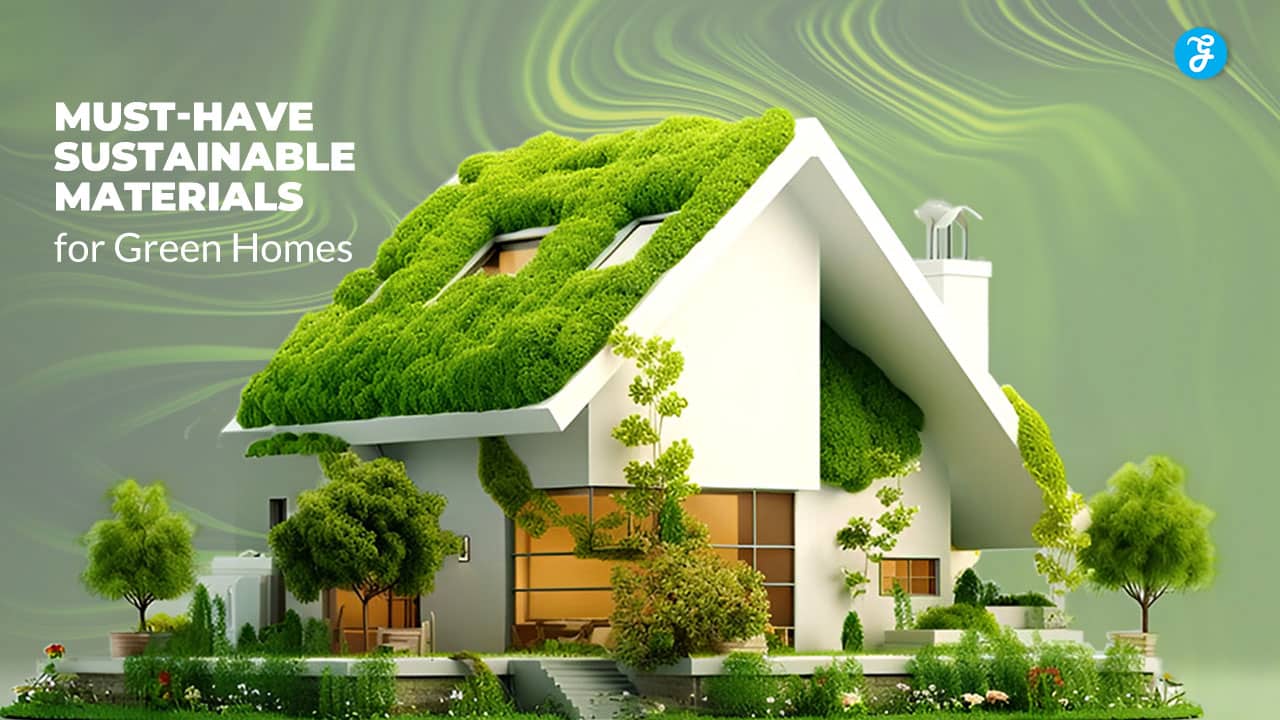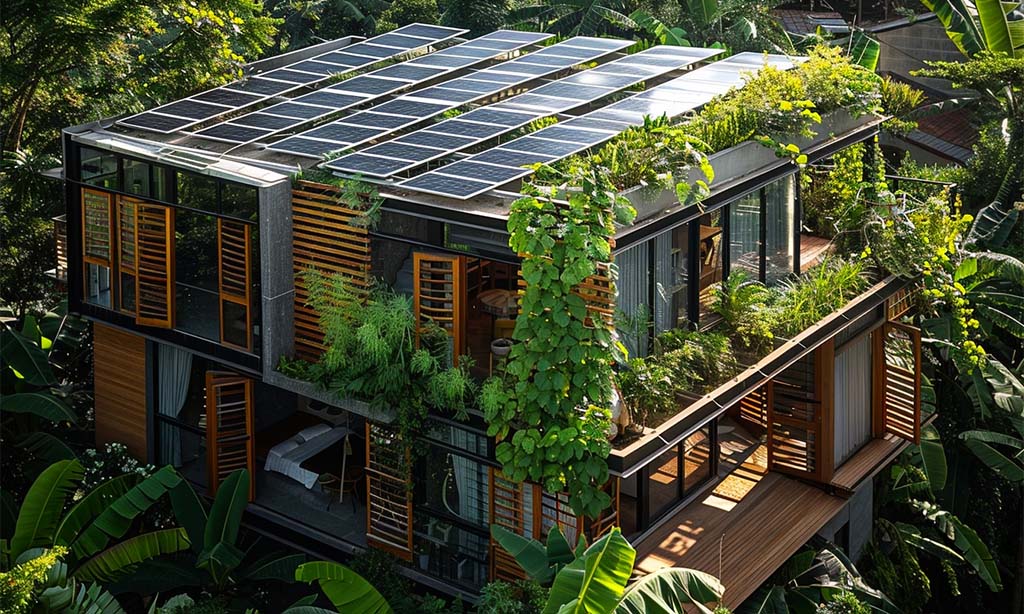As the environmental impact of traditional building materials becomes more apparent, sustainable alternatives are gaining popularity in the construction and renovation industries.
Whether you’re building a brand-new home or renovating an existing one, incorporating sustainable materials is crucial for reducing your carbon footprint, conserving resources, and promoting long-term eco-friendliness.
A green home doesn’t just minimize energy use; it incorporates materials that are renewable, recyclable, and sourced responsibly.
In this article, we’ll dive deeper into 12 must-have sustainable materials for green homes in 2025, exploring their benefits, why they’re important, and how they contribute to a healthier planet.
12 Sustainable Materials for Green Homes
Here are 12 sustainable materials that you must have for your green homes.
1. Bamboo Flooring
Why It’s Sustainable: Bamboo is one of the fastest-growing plants on the planet, capable of reaching maturity in just 3-5 years. Unlike hardwood trees, which can take decades to grow, bamboo can be harvested without causing harm to the plant. Bamboo flooring, which is made from these fast-growing plants, is an excellent sustainable alternative to traditional hardwood flooring.
Detailed Benefits:
- Eco-Friendly: Bamboo is renewable, requiring far less energy to produce compared to conventional hardwood.
- Highly Durable: Bamboo is stronger than some hardwoods, such as oak, and has a natural resistance to pests and moisture, making it an excellent choice for high-traffic areas and even kitchens and bathrooms.
- Low Maintenance: Bamboo is easy to clean and maintain, requiring minimal upkeep while retaining its beauty for many years.
- Natural Aesthetic: Bamboo offers a sleek, contemporary look and can be stained or finished in a variety of ways to match any décor style.
Why Choose Bamboo Flooring: Bamboo flooring is not only durable and versatile but also an ethical choice for green homeowners. It also improves indoor air quality by being naturally hypoallergenic and doesn’t release harmful VOCs, making it ideal for families with allergies.
2. Reclaimed Wood
Why It’s Sustainable: Reclaimed wood is salvaged from old barns, warehouses, factories, and even demolished buildings, which means it doesn’t require the cutting down of new trees. Instead of contributing to deforestation, reclaimed wood is reused, reducing landfill waste and cutting down on the need for new raw materials.
Detailed Benefits:
- Unique and Charming: Reclaimed wood often has a weathered look, rich with character and history, giving your home a distinct, one-of-a-kind feel.
- Durable and High-Quality: Old-growth wood, which is often what reclaimed wood is made from, is denser and stronger than most new wood, ensuring longevity.
- Reduction in Waste: By repurposing old wood, you keep it out of landfills, contributing to waste reduction.
- Carbon Footprint Reduction: By using reclaimed wood, you help lower the carbon footprint associated with cutting down new trees and processing fresh lumber.
Why Choose Reclaimed Wood: Reclaimed wood can be used for flooring, accent walls, furniture, or cabinetry. It is especially popular in rustic, farmhouse, and industrial-style homes, but it also works well in contemporary settings.
3. Hempcrete
Why It’s Sustainable: Hempcrete is an innovative and eco-friendly building material made from hemp stalks mixed with lime and water. Unlike traditional concrete, which is carbon-intensive to produce, hempcrete is carbon-negative, meaning it absorbs more CO2 during production than is emitted. This makes it an excellent option for green homes looking to lower their environmental impact.
Detailed Benefits:
- Carbon-Negative: Hempcrete sequesters carbon, reducing your home’s overall carbon footprint.
- Thermal Efficiency: It provides excellent thermal insulation, making your home more energy-efficient and reducing heating and cooling costs.
- Breathable and Non-Toxic: Hempcrete is highly breathable, which helps regulate indoor humidity levels and prevents mold and mildew growth. It’s also free from harmful chemicals, making it a non-toxic building material.
- Pest-Resistant: Hempcrete is naturally pest-resistant, reducing the need for toxic pesticides and chemical treatments.
Why Choose Hempcrete: Hempcrete is ideal for environmentally-conscious homeowners who want to create a truly sustainable structure. It’s particularly effective in regions that experience extreme temperatures, as it keeps homes cool in the summer and warm in the winter.
4. Cork
Why It’s Sustainable: Cork is harvested from the bark of cork oak trees, which naturally regenerate after being stripped, making it an infinitely renewable resource. Unlike cutting down trees for timber, the cork harvesting process does not harm the tree, and it allows the cork oak to continue growing.
Detailed Benefits:
- Energy-Efficient Insulation: Cork provides natural thermal and acoustic insulation, helping to regulate the internal temperature of the home and reducing noise.
- Fire-Resistant: Cork is naturally fire-resistant without the need for added chemicals, making it a safe choice for homes.
- Durability: Cork is highly resilient, bouncy, and will not degrade over time like many synthetic materials.
- Low Environmental Impact: The production of cork flooring and other cork products is environmentally friendly, using less energy than many other alternatives.
Why Choose Cork: Cork flooring is versatile and available in many finishes and colors. It is ideal for eco-conscious homeowners who want a material that is not only beautiful but also sustainable, safe, and comfortable underfoot.
5. Recycled Steel
Why It’s Sustainable: Steel is the most recycled material in the world. Using recycled steel significantly reduces energy consumption compared to producing new steel from raw iron ore, which is highly energy-intensive. Steel’s long lifespan and recyclability make it a top choice for sustainable construction.
Detailed Benefits:
- Durability and Strength: Recycled steel is just as strong and durable as new steel, making it an excellent material for structural components, including beams, framing, and roofing.
- Corrosion-Resistant: Steel is naturally resistant to corrosion, rust, and wear, making it a low-maintenance material that can last for decades.
- Sustainability: Recycling steel conserves natural resources and significantly reduces carbon emissions.
Why Choose Recycled Steel: Recycled steel is an ideal material for anyone looking to build a strong, long-lasting, and eco-friendly home. It can be used in a variety of applications, including framing, roofing, and even furniture.
6. Low-VOC Paints
Why It’s Sustainable: Traditional paints contain volatile organic compounds (VOCs), which can release toxic fumes into the air, contributing to indoor air pollution and causing health issues such as headaches and respiratory problems. Low-VOC paints, on the other hand, contain fewer chemicals and are less harmful to both people and the environment.
Detailed Benefits:
- Improved Indoor Air Quality: Low-VOC paints ensure that your home’s air remains clean and free from harmful chemicals.
- Non-Toxic: They are safer for sensitive individuals, including children, elderly people, and pets.
- Wide Range of Colors: Low-VOC paints come in a vast array of colors and finishes, so you don’t have to sacrifice style for sustainability.
Why Choose Low-VOC Paints: Low-VOC paints help improve the air quality in your home while offering an eco-friendly way to beautify your walls. It’s an essential element for a green home, especially in areas where air quality is a concern.
7. Recycled Glass
Why It’s Sustainable: Recycled glass is made from previously used glass products, such as bottles, containers, and windows, which are melted down and repurposed for new uses. It’s one of the most eco-friendly materials available since it reduces waste and requires significantly less energy than producing new glass.
Detailed Benefits:
- Environmentally Friendly: Using recycled glass reduces the need for raw materials, such as sand and soda ash, which are mined and processed to make new glass.
- Durable and Non-Toxic: Glass is non-toxic, fire-resistant, and can be recycled indefinitely without losing quality.
- Versatile and Beautiful: Recycled glass can be used for countertops, tiles, and even decorative elements like glass sculptures, mosaic tiles, and lighting fixtures.
Why Choose Recycled Glass: Recycled glass is a perfect choice for eco-friendly kitchen countertops, bathroom tiles, and even decorative home accents. It’s easy to clean, stylish, and contributes to a more sustainable building process.
8. Straw Bale Construction
Why It’s Sustainable: Straw bale construction uses the bales of straw, a byproduct of wheat, rice, and other grains, as the primary material for building walls. This method offers superior insulation, keeping homes warm in winter and cool in summer while also being a highly sustainable material.
Detailed Benefits:
- Thermal Efficiency: Straw bales provide excellent insulation and are perfect for energy-efficient homes.
- Carbon Sequestration: Straw is a renewable resource, and using it in construction helps sequester carbon in the walls of your home.
- Cost-Effective: Straw is often less expensive than conventional building materials, making it an affordable option for homeowners looking to build green.
Why Choose Straw Bale Construction: If you’re building a home in a rural or agricultural area, straw bale construction is a natural, local, and cost-effective choice. It’s ideal for those looking to create homes with high energy efficiency and minimal environmental impact.
9. Solar Panels
Why They’re Sustainable: Solar panels are one of the most effective ways to reduce your carbon footprint and lower your energy bills. They harness the sun’s free energy, converting it into electricity that can be used to power your home, which significantly reduces reliance on fossil fuels.
Detailed Benefits (continued):
- Clean Energy Source: Solar panels produce no greenhouse gas emissions during operation, making them a clean and renewable energy source.
- Long-Term Savings: Although the initial installation cost can be high, solar panels drastically reduce energy bills over time and may even provide enough energy to make your home energy-independent.
- Low Maintenance: Once installed, solar panels require very little maintenance and have a lifespan of 25+ years, offering a strong return on investment.
Why Choose Solar Panels: If you want to make your home greener and reduce your reliance on conventional electricity sources, solar panels are an essential sustainable material. They help create an off-the-grid lifestyle and can even increase the value of your home due to the growing demand for green homes.
10. Wool Insulation
Why It’s Sustainable: Wool is a natural, biodegradable material that can be used as insulation in green homes. Sourced from sheep, wool is an abundant resource and has excellent thermal properties that help keep homes at a comfortable temperature year-round. Wool insulation is especially known for its ability to regulate moisture, preventing mold and mildew growth.
Detailed Benefits:
- Natural Insulator: Wool is an excellent thermal insulator, helping to maintain a steady internal temperature in your home.
- Moisture Control: Unlike synthetic insulation materials, wool can absorb moisture and still retain its insulating properties, which helps prevent mold and mildew build-up.
- Carbon-Sequestering: Wool absorbs carbon dioxide during its growth process, which makes it a carbon-positive material over its lifetime.
- Fire-Resistant: Wool is naturally flame-resistant and does not emit toxic fumes when it burns, making it a safer insulation choice.
Why Choose Wool Insulation: Wool is an ideal material for homeowners looking to reduce their carbon footprint and improve their home’s energy efficiency. It’s a great choice for eco-conscious families who want the added benefits of natural insulation with superior moisture control.
11. Living Green Walls (Vertical Gardens)
Why They’re Sustainable: Living green walls, or vertical gardens, are an innovative and beautiful way to incorporate nature into the home. These walls are planted with a variety of vegetation, either indoors or outdoors, that helps improve air quality and add natural beauty to spaces while promoting sustainability.
Detailed Benefits:
- Improved Air Quality: Plants absorb CO2 and release oxygen, improving indoor air quality and providing a more pleasant living environment.
- Energy Efficiency: Green walls can help reduce heating and cooling costs by providing natural insulation. Outdoor living walls can also reduce urban heat island effects.
- Aesthetic Appeal: A green wall transforms any space, whether it’s a home’s interior or the exterior façade, adding texture, color, and life to your surroundings.
- Biodiversity Boost: Green walls contribute to urban biodiversity by supporting a variety of plant and animal life, such as insects, birds, and small mammals.
Why Choose Green Walls: For eco-conscious homeowners who are looking to blend nature with modern design, living green walls are an excellent choice. They offer both environmental and aesthetic benefits, making them a standout feature in sustainable homes.
12. Clay Plaster
Why It’s Sustainable: Clay plaster is a natural alternative to synthetic wall coverings and paints. It is made from clay, sand, and natural pigments and is often used as a wall finish in green homes. The production of clay plaster has a low environmental impact, and it can be recycled and composted once it’s no longer in use.
Detailed Benefits:
- Non-Toxic and Safe: Unlike many paints and finishes that contain harmful chemicals, clay plaster is completely non-toxic and safe for both the environment and the people inside your home.
- Natural Insulation: Clay plaster provides a slight thermal mass, helping to regulate the temperature in your home by absorbing and slowly releasing heat.
- Humidity Control: Clay plaster has the ability to absorb and release moisture, making it ideal for homes in humid climates. It helps reduce the risk of mold and improves indoor air quality.
- Aesthetic Appeal: Clay plaster has a beautiful, organic appearance that adds warmth and texture to your home. It comes in various colors and finishes, allowing you to customize your interior design.
Why Choose Clay Plaster: For those who want a natural, healthy, and aesthetically pleasing finish for their walls, clay plaster is an excellent choice. It is particularly suitable for creating a comfortable and healthy indoor environment and aligns with sustainable living practices.
Takeaways
As we move toward a more sustainable future, the materials we choose for building and renovating homes play a pivotal role in reducing our environmental impact. Incorporating sustainable materials into your home not only benefits the planet but also improves your living conditions, energy efficiency, and long-term savings.
From renewable options like bamboo and hempcrete to recyclable materials such as recycled glass and steel, there are numerous ways to make your home greener and more eco-friendly.
By selecting these 12 must-have sustainable materials, you are contributing to a more sustainable world while creating a healthier, more efficient living space for you and your family.
As you embark on your green home journey, remember that every small decision counts, and with these materials, you’re making a significant impact on both your home and the planet.
FAQs
Q1: What are the most important considerations when choosing sustainable materials for a green home?
When choosing sustainable materials, consider factors such as the material’s environmental impact (carbon footprint), durability, recyclability, energy efficiency, and how it contributes to the overall health of the indoor environment (air quality, moisture control, etc.).
Q2: Are sustainable materials more expensive than conventional ones?
Some sustainable materials, like bamboo and recycled steel, can be more expensive upfront due to the manufacturing processes. However, many sustainable options, such as reclaimed wood and straw bale construction, can be more affordable than traditional materials, and their long-term benefits (energy savings, reduced maintenance costs) make them cost-effective in the long run.
Q3: Can I find sustainable materials for both new builds and renovations?
Yes, many sustainable materials are available for both new construction and renovation projects. For example, bamboo flooring, low-VOC paints, and recycled glass countertops are versatile enough to be used in a variety of design scenarios.







































